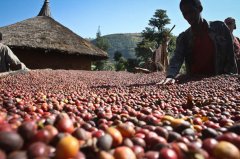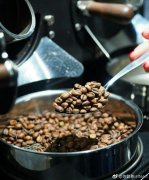How to become a professional coffee roaster coffee roasting experience
For more professional coffee exchanges, please scan the code and follow Wechat: FrontStreetCoffee
In Europe at the beginning of April. Seven bakers bake Costa Rica with the same machine and the same baking degree. Tarasu. In terms of techniques, they are all different, at least in details, so who is right? Everyone has to go back to the cupping desk for answers.
Some people adjust the fire three times after an explosion to change the curve, while others are slightly dull and adjust only once until the end. The second important point about coffee roasting is the understanding and understanding of raw beans, which is a bit like those who use traditional film cameras to learn photography, whose grades are piled up by film, so a good roaster is piled up by the amount of raw beans baked.
Coffee roasting should be practiced from three levels: first, understanding utensils, second, understanding coffee. Third, understanding the taste of these three levels is not isolated but cyclic interaction with each other, with the increase of coffee bean surface temperature and the decrease of the temperature difference between bean surface and bean core, a considerable proportion of water has escaped in this process. If you look at the sample in the sampling rod at this time, you will find that a light yellowish brown begins to appear, and then look down and smell it, and the original pure smell of hay is replaced by a hint of sweetness, which means that the time has come for chemical reaction to dominate baking. At this time, we should give enough heat supply so that a large number of chemical reactions that need to absorb heat and produce charming flavor can be carried out smoothly. It is precisely because of the addition of a large number of endothermic chemical reactions that the temperature rise slope of coffee beans we have observed began to slow down. With the continuous absorption of heat, more and more volatile gases (mainly water vapor) accumulate in the coffee beans, which causes the pressure inside the beans to far exceed the external atmospheric pressure, even reaching 25 atmospheric pressure (2533 kPa). The internal pressure is so high that it is like a small bomb that is finally enough to tear the structure of the raw coffee beans. This critical moment is called First Crack.
In a sense, as long as there is an explosion of coffee beans, they can be cooled, ground and drunk, but it is still a very shallow baking degree, which may not be the best baking degree we want. Next, we should pay close attention to the stage of roasting, observe the color of coffee raw beans by sampling, smell the aroma changes of coffee raw beans, find the best baking degree, and then cool it decisively. We know that the ingredients in raw coffee beans are in the following order: sugars, moisture, fatty substances, proteins, acids, minerals, alkaloids (such as caffeine) and other volatile aromatic substances. The content of these substances essentially determines the flavor of a cup of coffee drink.

Important Notice :
前街咖啡 FrontStreet Coffee has moved to new addredd:
FrontStreet Coffee Address: 315,Donghua East Road,GuangZhou
Tel:020 38364473
- Prev

The skill of judging the roasting degree of coffee beans
Professional barista communication Please pay attention to the concentration of smoke when roasting coffee beans in the coffee workshop (Wechat official account cafe_style). When the coffee beans enter the second explosion, there will be a smoking state, so the roasting degree of coffee beans can also be judged by the smoke concentration. This judgment method is not aimed at all coffee beans, because of the different characteristics of various beans, so it is not necessary in practice.
- Next

Coffee bean roasting is a chemical reaction that takes place. Coffee flavor is reflected.
The structure of coffee is a well-developed matrix, which improves the consistency of quality and contributes to the uniform spread of heat during baking. Cellulose exists in coffee in the form of embedded in lignocellulose (an amorphous matrix containing hemicellulose and cellulose-containing lignin), which form matrix unit walls (cell walls). Hemicellulase (hemicel)
Related
- Beginners will see the "Coffee pull flower" guide!
- What is the difference between ice blog purified milk and ordinary milk coffee?
- Why is the Philippines the largest producer of crops in Liberia?
- For coffee extraction, should the fine powder be retained?
- How does extracted espresso fill pressed powder? How much strength does it take to press the powder?
- How to make jasmine cold extract coffee? Is the jasmine + latte good?
- Will this little toy really make the coffee taste better? How does Lily Drip affect coffee extraction?
- Will the action of slapping the filter cup also affect coffee extraction?
- What's the difference between powder-to-water ratio and powder-to-liquid ratio?
- What is the Ethiopian local species? What does it have to do with Heirloom native species?

